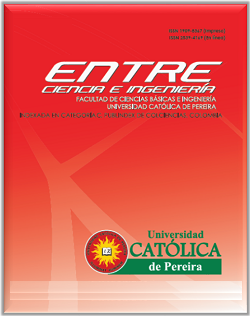Simulation-level performance analysis of a Li-Fi communications system for high-speed data transmission
DOI:
https://doi.org/10.31908/19098367.1786Keywords:
ACO-OFDM, BER, Li-Fi, multipath, hermitian, symmetry, VLCAbstract
The high wireless requirements in access, capacity and security demanded by today's society together with the great congestion of the radio spectrum has led to looking for new technological solutions such as Light Fidelity (Li-Fi). This paper shows the design and implementation of a Li-Fi communications system within an indoor environment used the optical OFDM modulation technique with asymmetric clipping (ACO-OFDM) through MATLAB software. System performance is analyzed in terms of bit error rate (BER) and bit to noise power ratio (Eb/No) taking into account receiver position, QAM modulation order and transmission rate. The results show that the performance of the system depends directly on the position of the receiver, in addition to high transmission rates the multipath degrades the performance of the system.
References
S. Douglas and T. Ely., “The Tecnologies of the information and communications necessary to the society of the information of XXI century,” СИМВОЛ НАУКИ, vol. 3, no.3, pp. 173–176, 2016.
J. Gómez., “Servicios en Red,” 1ra ed, Ed. Editex, pp. 212–214, 2010.
S. Dhawan, “Analogy of Promising Wireless Technologies on Different Frequencies: Bluetooth, WiFi, and WiMAX,” in The 2nd International Conference on Wireless Broadband and Ultra Wideband Communications, Sidney, pp. 14–14, 27-30 Aug. 2007.
S. Singh and N. Singh, “Internet of Things (IoT): Security challenges, business opportunities & reference architecture for E-commerce,” in 2015 International Conference on Green Computing and Internet of Things (ICGCIoT), Noida, pp. 1577–1581, 8-10 Oct. 2015.
M. O. Gokalp, K. Kayabay, M. A. Akyol, P. E. Eren, and A. Kocyigit, “Big Data for Industry 4.0: A Conceptual Framework,” in 2016 International Conference on Computational Science and Computational Intelligence (CSCI), Las Vegas, pp. 431–434, 15-17 Dec. 2016.
M. Monisha and G. Sudheendra, “Lifi- Light Fidelity Technology,” in International Conference on Current Trends in Computer, Electrical, Electronics and Communication (CTCEEC), Mysore, pp. 818–821, 8-9 Sept. 2017.
V. Shah, S. Chaudhary and B. Jain, “Architecture based on Li-Fi to enhance the working environment,” Int. J. Adv. Res. Comput. Commun. Eng. ISO, vol. 6, no. 2, pp. 226–229, Feb. 2017.
R. Mesleh, H. Elgala, and H. Haas, “On the Performance of Different OFDM Based Optical Wireless Communication Systems,” J. Opt. Commun. Netw., vol. 3, no. 8, pp. 620-628, Aug. 2011.
S. D. Dissanayake and J. Armstrong, “Comparison of ACO-OFDM, DCO-OFDM and ADO-OFDM in IM/DD Systems,” J. Light. Technol., vol. 31, no. 7, pp. 1063–1072, Apr. 2013.
B. Ranjha and M. Kavehrad, “Hybrid asymmetrically clipped OFDM-based IM/DD optical wireless system,” J. Opt. Commun. Netw., vol. 6, no. 4, pp. 387–396, May. 2014.
S. J. Lee and S. Y. Jung., “A SNR analysis of the visible light channel environment for visible light communication,” in 2012 - 18th Asia-Pacific Conference on Communications (APCC),” Jeju Island, pp. 709–712, 15-17 Oct. 2012.
Nichia Corporation, “Technical Datasheet White LED NF2W757GRT-V1 ”, 2016.
OSRAM Opto Semiconductors, "Technical Datasheet photodetectro BPW-34”, 2018.
Z. Ghassemlooy, W. Popoola, and S. Rajbhandari, “Optical wireless communications : system and channel modelling with MATLAB,” 2nd ed, Boca Raton, Ed. CRC Press Taylor and Francis Group, 2019.
Z. Ghassemlooy, L. N. Alves, S. Zvanovec, and M. Khalighi, “Visible light communications : theory and applications,” 1ra ed, Boca Raton, Ed. CRC Press Taylor and Francis Group, 2017.
L. Zeng, D. O’Brien, H. Le-Minh, K. Lee, D. Jung, and Y. Oh, “Improvement of Date Rate by using Equalization in an Indoor Visible Light Communication System,” in 2008 4th IEEE international Conference on Circuits and Systems for Communications, Shanghai, pp. 678–682, 26-28 May. 2008.
X. Zhang, Y. Zhou, Y. Yu, P. Han, and X. Wang, “Comparison and Analysis of DCO-OFDM, ACO-OFDM and ADO-OFDM in IM/DD Systems,” Applied Mechanics and Materials., vol. 701–702, pp. 1059–1062, Dec. 2014.
S. C. Saju and A. J. George., “Comparison of ACO-OFDM and DCO-OFDM in IM/DD Systems,” Int. J. Eng. Res. Tecnol., vol. 4, no. 04, pp. 1315-1318, Apr. 2015.
J. Armstrong and B. Schmidt, “Comparison of asymmetrically clipped optical OFDM and DC-biased optical OFDM in AWGN,” IEEE Commun. Lett., vol. 12, no. 5, pp. 343–345, May. 2008.








 Revista Entre Ciencia e Ingeniería
Revista Entre Ciencia e Ingeniería .png) entrecei@ucp.edu.co
entrecei@ucp.edu.co.png) ISSN (Impreso) 1909-8367 - ISSN (En Línea) 2539-4169
ISSN (Impreso) 1909-8367 - ISSN (En Línea) 2539-4169 Attribution-NonCommercial 4.0 International (CC By-NC 4.0)
Attribution-NonCommercial 4.0 International (CC By-NC 4.0)
.png) Carrera 21 No. 49-95 Av. de las Américas, Pereira, Risaralda, Colombia
Carrera 21 No. 49-95 Av. de las Américas, Pereira, Risaralda, Colombia